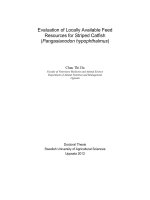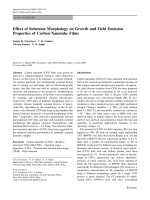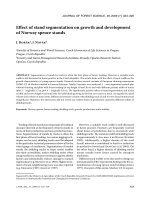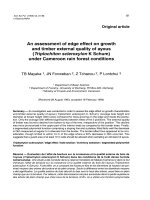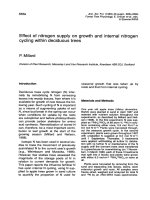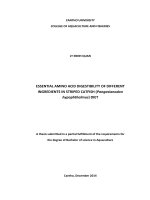Effect of oligochitosan supplementation on growth and innate immunity of striped catfish (Pangasianodon hypophthalmus) at pond culture
Bạn đang xem bản rút gọn của tài liệu. Xem và tải ngay bản đầy đủ của tài liệu tại đây (265.96 KB, 6 trang )
Nuclear Science and Technology, Vol.7, No. 2 (2017), pp. 32-37
Effect of oligochitosan supplementation on growth and innate
immunity of striped catfish (Pangasianodon hypophthalmus)
at pond culture
Nguyen Ngoc Duy1, Dang Van Phu1, Le Anh Quoc1, Nguyen Thi Kim Lan1,
Nguyen Quoc Hien1, Pham Duy Hai2, Nguyen Van Nguyen2
1
Research and Development Center for Radiation Technology, Vietnam Atomic Energy Institute,
Thu duc District, Ho Chi Minh City
2
Research Institute for Aquaculture No.2, 1 District, Ho Chi Minh City
Email:
(Received 09 November 2017, accepted 05 December 2017)
Abstract: Oligochitosan (COS) was prepared by gamma Co-60 irradiation of chitosan/H2O2 solutions
and mixed with cornstarch to form the powder with content of 100 000 mg COS/kg. The striped
catfish (P. hypophthalmus) was fed with diets containing 100 mg COS/kg feed for 9 months at pond
culture. The effects of COS supplementation on growth performance, feed conversion ratio (FCR) and
survival rate in striped catfish were investigated. The results indicated that the growth performance
and survival rate of striped catfish fed with 100 mg COS/kg were significantly improved and the FCR
decreased. The average weight gain, survival rate and FCR of striped catfish fed with diets containing
COS were 971 ± 85 gram, 83.19 ± 0.35 % and 1.477 ± 0.013 in comparison with 896 ± 78 gram,
78.43 ± 0.64 % and 1.578 ± 0.038 of control group, respectively. Thus, COS can be potentially
utilized as immunostimulants and growth promoter for aquaculture.
Keywords: Oligochitosan; Striped catfish; Immunostimulant; Survival rate.
I. INTRODUCTION
The striped catfish (Pangasianodon
hypophthalmus) is one of the most important
commercial fish species in South-East Asia,
particularly in Mekong Delta, of Vietnam
due to a big profit from annual catfish export
[1]. The rapid expansion of culture and high
farming intensity under inappropriate control
resulted in serious diseases for striped catfish
[2].
Nowadays,
the
use
of
immunostimulants deriving from natural
polysaccharides for increasing the nonspecific immune response has received
considerable attention and became an
alternative method for the prevention and
control of various diseases in aquaculture.
Chitosan is commonly prepared by sodium
hydroxide deacetylation of chitin from crab,
shrimp shells and squid pens, and consists of
glucosamine and N-acetyl glucosamine units
linked by β(1–4) glycoside bonds [3].
Chitosan has many unique properties such as
antimicrobial activity [4], antioxidant
activity and antitumor activity [5]. These
features, combined with the biocompatibility,
biodegradability and non-toxicity implies
that chitosan is an interesting polymer for
several applications in medicine, cosmetic,
biotechnology, food and agriculture [6]. In
aquaculture, due to the ability to enhance the
non-specific immunity and resistance against
pathogenic infection, chitosan is utilized as
an immunostimulant [7, 8]. Several feeding
trials and in vitro tests have shown that
chitosan is able to enhance the resistance of
©2017 Vietnam Atomic Energy Society and Vietnam Atomic Energy Institute
NGUYEN NGOC DUY et al.
aquatic animals against infections as well as
immune capacities such as phagocytosis,
superoxide anion production and lysozyme
activity in fishes [9-13]. Other reports have
shown immune stimulatory activity of
chitosan in range of fish including koi,
(Ciprinus carpio koi) [9, 10], rainbow trout
(Oncorhynchus mykiss) [11, 12], ovate
pompano (Trachinotus ovatus) [13], kelp
grouper (Epinephelus bruneus) [14], tilapia
(Oreochromis niloticus) [15].
II. MATERIALS AND METHODS
A. Oligochitosan preparation
Chitosan from shrimp shell with
molecular weight (Mw) of 91.7 kDa and
deacetylation degree of 91.3% was purchased
from Chitosan Co., Vung Tau province.
Chitosan was swollen in solution hydrogen
peroxide (H2O2) at 1% concentration with ratio
1:20 (w/v) for 24 h. Then, 2% (w/v) lactic acid
solution was added into the mixture to dissolve
completely chitosan. A required amount of 30%
H2O2 was added together with water to prepare
solutions with concentration of 5% chitosan
(w/v) and 0.5% H2O2 (w/v). Then, the resulting
solutions were irradiated under ambient
temperature on gamma SVST Co-60/B
irradiator at the VINAGAMMA Center with the
absorbed dose up to 20 kGy and the dose rate of
1.13 kGy/h. The Mw of COS measured by gel
permeation chromatography (GPC), LC 20AB,
Shimadzu was of 5600 Da. Oligochitosan
solution was mixed with corn starch at 100 000
mg/kg, and then dried and grinded by grinder
machine to form powder (COS/CS).
In spite of these advantages, chitosan
also has several drawbacks including poor
solubility under physiological functions [10].
To improve these poor physicochemical
properties, oligochitosan (COS) has been
prepared and used. COS has a higher activity
and more physiological functions than
chitosan due to their low molecular weight,
good solubility and low viscosity [16]. COS
was recently shown to have immuneenhancing characteristics and protect against
pathogenic infections [18, 20]. In our previous
study, the effects of COS supplementation on
immune stimulation and growth performance
in striped catfish were investigated at
laboratory scale [17]. The results indicated
that for striped catfish fed with COS, the
growth performance was significantly
improved with the decrease in mortality.
Striped catfish fed with 100 mg COS/kg feed
was the highest increase of weight gain
(~26%) and decrease of mortality (38.73%)
compared with control group. However, not
much data are available on administering COS
as immunostimulant to improve the growth
performance and immune response of fish at
large-scale. Therefore, the aim of the present
study was to investigate the effect of COS
prepared by gamma Co-60 on growth and
innate immunity of striped catfish (P.
hypophthalmus) at pond culture.
B. Diet preparation
The ingredient basal diet (control)
comprised 22÷30% crude protein, 6 ÷ 10%
crude lipid, 10÷14% crude ash and 6-8% fiber.
To prepare the experimental diet, the basal diet
was mixed with COS/CS at 100 mg COS/kg.
The ingredients of the experimental diet were
well-mixed and extruded through a pelletizer
machine at the feed factory in Long An
province. Total required amount of feed for
testing is about 600 tons.
C. Fish and experimental conditions
Fish
Eight hundred thousand striped catfishes
(Pangasianodon hypophthalmus) of 44.4 8.1
g in body weight were brought from National
33
EFFECT OF OLIGOCHITOSAN SUPPLEMENTATION ON GROWTH AND INNATE IMMUNITY …
Breeding Centre for Southern Freshwater
Aquaculture, Tien Giang city, Vietnam. They
were allowed acclimatizing to pond conditions
for 30 days prior to use in experiments. The
fishes were divided randomly into 5 ponds.
The basic physico-chemical water parameters
such as dissolved oxygen, NH3, pH and
temperature were checked daily to maintain the
optimal level. The water temperature was
controlled within the range of 25 – 28 oC.
During the acclimatization period, fishes were
fed daily with the basal diet.
Experimental design
This study comprises 5 ponds. Pond 1, 2
and 3 the striped catfish were fed diets with
100 mg COS/kg feed. Pond 4 and 5 the striped
catfish were fed diets with no COS
supplementation. All experiments were
designed as in table I:
Table I. Area surface water , number of fish per pond, density and average weight of fish of each experiments
Pond
A1
A2
A3
A4
A5
Area surface water (m2)
2400
2500
2800
2500
2260
Number of fish per pond
154800
152500
178000
162000
145600
Density (fish/m2)
65
61
64
65
64
Average weight (g/a fish)
41.5 8.3
38.4 8.1
40.3 7.9
51 8.5
51 8.4
In all experiments, fishes were fed at the
rate 1-10% of the body weight, twice a day for
9 months.
Statistics analysis
All the results were statistically analyzed
by analysis of variance (ANOVA; MSTAT C,
version. 1.2, Ann Arbor, MI, USA, 1989). The
means were compared using the least
significant difference (LSD) at 0.05 probability
level (P < 0.05).
Survival rate and growth performance
Every month, 30 fish were caught
randomly to measure body weight in order to
calculate weight gain and the growth rate.
Mortality of fish in each pond was recorded
daily up to 9 months. At the end termination
of the experiment, the fishes were fasted for
24h before harvest. Total number was counted
and mean body weight of fish was measured.
Based on the weight of each fish and the
number of striped catfishes, weight gain
(WG), survival and feed conversion ratio
(FCR) were calculated as follows:
III. RESULTS AND DISCUSSION
A. Growth performance and feed conversion
ratio (FCR)
Several researches have showed
relationship between immunostimulant and
growth performance. In our previous study at
laboratory condition, stripped catfish were fed
COS at 50, 100 and 200 mg/kg concentration
for 45 days. The results showed that dietary
supplementation
of
COS
significantly
enhanced the growth performance and 100 mg
COS/kg feed was optimal concentration of
WG = final weight (g) – initial weight (g)
Survival (%) = 100 × (final number of striped
catfish ÷ initial number of striped catfish)
FCR = Feed given (dry weight) ÷ weight gain
(wet gain)
34
NGUYEN NGOC DUY et al.
COS as immunostimulant for striped catfish.
Therefore, in this study 100 mg COS/kg feed
was selected to evaluate the effect of COS
supplementation on growth and innate
immunity of striped catfish at pond culture.
Table II presented the growth performance data
for striped catfish after 9 months experiment.
The results clearly showed that the final weight
and weight gain of striped catfish fed with 100
mg COS/kg feed was higher than those of the
control groups. The average weight gain of
striped catfish fed with diets containing COS
was 971± 85 g compare to 896 ± 78 g of
control group. In addition, the FCR of striped
catfish feeding by COS was lower than those
of control. The average FCR reduced from
1.578 ± 0.038 for the control groups to 1.477 ±
0.013 for COS supplementation groups.
Table II: Growth parameters and FCR of the striped catfish fed with the basal diets and diets
containing 100 mg COS/kg after 9 months of feeding trial (mean ± SD)
Treatment
Initial weight
(g)
Final
weight (g)
Weight
gain (g)
FCR
A1*
41.5 8.3
995 61
954 54
1.464
*
38.4 8.1
1026 112
985 108
1.476
A3*
40.3 7.9
1015 95
974 94
1.489
A4**
51 8.5
892 78
841 76
1.604
**
51 8.4
900 84
849 81
1.551
A2
A5
Average
Weight gain
(g)
Average
971 ± 85a
1.477 ±
0.013a
896 ± 78b
1.578 ±
0.038b
FCR
**,
Control: without supplementation of COS; * Supplementation of 100 mg COS/kg. The mean values in a
column with the same letter are not significantly different (P<0.05).
The influences of dietary COS
supplementation on growth have been
investigated with several aquaculture species
with varied results. According to Lin et al.
[10] dietary COS supplementation at 4000
mg/kg feed enhanced the growth of Derbio
pompano (Trachinotus ovatus). A similar
result was also observed in the study of Lin
et al. [13] dietary supplementation with COS
at level 500 mg/kg also enhanced the growth
of koi (Cyprinus carpio koi). To date, how
the immunostiumulants work to enhance the
growth is not clear yet. Lin et al. proposed
one hypothesis that after administration, a
local intestinal inflammatory response
induces resistance against pathogens which
otherwise would result in the decrease in
weight gain [18].
B. Survival rate
Infectious
disease
and
adverse
environmental
condition
are
major
impediments to the development of
aquaculture, which lead to production and
economic loss. The use of natural
immunostimulant in aquaculture has been
considered as an environmentally friendly
method because they are biocompatible,
biodegradable
and harmless
for
the
environment and human health [10, 13].
Average survival rate of striped catfish fed
with diets with and without 100 mg COS/kg
feed were presented in table III. The results of
the present study clearly showed that dietary
COS enhanced survival rate of striped catfish.
The average survival of striped catfish fed with
100 mg COS/kg feed in A1, A2 and A3 ponds
35
EFFECT OF OLIGOCHITOSAN SUPPLEMENTATION ON GROWTH AND INNATE IMMUNITY …
for 9 months was 83.19 ± 0.35% compare to
that of 78.43 ± 0.64% in control ponds. The
increase in the survival rate of striped catfish
fed with COS may be explained by the
augmentation of non-specific immunity,
leading to the enhancement of the fish health
and improvement of fish resistance against
unfavorable environmental conditions.
Table III. Survival rate of the striped catfish fed with the basal diets and diets containing 100 mg
COS/kg after 9 months of feeding trial
Treatment
Initial number of
fish
Final number of
fish
Survival rate
(%)
A1*
154800
128484
83.00
*
152500
127503
83.61
A3*
178000
147740
83.00
**
162000
126360
78.00
A2
A4
**
Average survival rate
(%)
83.19 ± 0.35a
78.43 ± 0.64b
145600
114890
78.91
A5
Control: without supplementation of COS; * Supplementation of 100 mg COS/kg. The mean values in a
column with the same letter are not significantly different (P<0.05).
**,
The effect of dietary COS on survival
rate has been studied by several authors.
According to Lin et al. [18], dietary of
chitosan significantly enhanced the nonspecific immunity of koi through the decrease
of average mortality and improvement of
relative percent survival (RPS) compared with
control group. Qin et al. [15] also indicated
that dietary supplementation with chitooligosaccharides significantly reduced the
inflammatory response in the intestine, which
subsequently enhanced the health status and
decreased the cumulative mortality of tilapia
after challenged with A. hydrophila.
survival rate of striped catfish fed with COS
compared to control group. Thus, the COS
could be the potential and promising
immunostimulant for improving weight gain,
survival rate, immune system and controlling
disease in fish culture.
ACKNOWLEDGEMENTS:
This research work was supported by
the Ministry of Science and Technology,
Vietnam
under
Project
No.
DTCB.06/16/TTNCTK. The authors are
thankful to VINATOM and VINAGAMMA
Center for providing necessary conditions
during implementation of this project.
IV. CONCLUSIONS
REFERENCES
The present study at pond culture
provided evidences that dietary COS at 100
mg/kg feed not only considerably improved
the growth performance but also reduced the
FCR of striped catfish for 9 months of
feeding trial. The benefit resulted by COS
supplement was manifested by the increase
weight gain as well as the improvement of
1.
2.
36
Hang, B.T.B., Phuong, N.T., Kestemont, P.,
“Can immunostimulants efficiently replace
antibiotic in striped catfish (pangasianodon
hypophthalmus) against bacterial infection by
Edwardsiella ictaluri?”, Fish and Shellfish
Immunology, 40, 556–562, 2014.
Kumaji, J., Swain, T., Sahoo, P.K., “Dietary
bovine lactoferrin induces changes in
NGUYEN NGOC DUY et al.
immunity level and disease resistance in Asia
catfish Clarias bastripedchus”, Veterinary
Immunology Immunopathology, 94, 1–9, 2003.
3. Rinaudo, M., “Chitin and Chitosan: Properties
and applications”, Progress in Polymer
Science, 31, 603–632, 2006.
4. Kong, M., Chen, X.G., Xing, K., Park, H.J.,
“Antimicrobial properties of chitosan and
mode of action: A state of the art review”,
International Journal of Food Microbiology,
15, 51–63, 2010.
5. Wan, A., Xu, Q., San, Y., Li, H., “Antioxidant
activity of high molecular weight chitosan and
N,O-quaternized chitosans”, Journal of
Agricultural and Food Chemistry, 61, 6921–
6928, 2013.
6. El-Sawy, N.M., El-Rehim, H.A.A., Elbarbary,
A.M., Hegazy, E.A., “Radiation-induced
degradation of chitosan for possible use as a
growth promoter in agriculture purpose”,
Carbohydrate Polymers, 79, 555–562, 2010.
7. Kumari, J., and Sahoo, P.K., “Non-specific
immune
response
of
healthy
and
immunocompromised Asian catfish (Clarias
batrachus) to several immunostimulants”,
Aquaculture, 255, 133–141. 2006.
8. Harikrishnan, R., Kim, J.S., Balasundaram, C.,
Heo, M.S., “Dietary supplementation with chitin
and chitosan on haematology and innate immune
response in Epinephelus bruneus against
Philasterides
dicentrarchi”,
Experimental
Parasitology, 131, 116–124, 2012.
9. Gopalakannan,
A.,
Arul,
V.,
“Immunodulatory effect of dietary intake of
chitin, chitosan and levamisole on the
immune system of Cyprinus carpio and
control of Aeromonas hydrophila infection in
ponds”, Aquaculture, 255, 179–187, 2006.
10. Lin, S., Mao, S., Guan, Y., Luo, L., Luo, L.,
Pan, Y., “Effects of dietary chitosan
oligosaccharides and Bacillus coagulans on
the growth, innate immunity and resistance of
koi (Cyprinus carpio koi)”, Aquaculture, 342–
343, 36–41, 2012.
11. Alishahi, A., Mirvaghefi, A., Tehrani, M.R.,
Farahmand, H., Koshio, S., Dorkoosh, F.A.,
“Chitosan nanoparticle to carry vitamin C
12.
13.
14.
15.
16.
17.
18.
37
through the gastrointestinal tract and induce
the non-specific immunity system of rainbow
trout (Oncorhynchus mykiss)”, Carbohydrate
Polymers, 86, 142–146, 2011.
Lin, L., Xuefeng, C., Chuan, H., Min, X.,
Xiufeng, W., Haining, C., “Immune response,
stress resistance and bacterial challenge in
juvenile rainbow trouts Oncorhynchus mykiss
fed diets containing chitosan-oligosaccharides”,
Current Zoology, 55, 1-14, 2009.
Lin, S., Mao, A., Guan, Y., Lin, X., Luo, L.,
“Dietary
administration
of
chitooligosaccharides to enhance growth,
innate immune response and disease resistance
of Stripedchinotus ovatus”, Fish and Shellfish
Immunology, 32, 909–913, 2012.
Harikrishnan, R., Kim, J.S., Balasundaram,
C., Heo, M.S., “Immunomodulatory effect of
chitin and chitosan enriched diets in
Epinephelus
bruneus
against
Vibrio
alginolyticus infection”, Aquaculture, 326329, 46–52, 2012.
Qin, C., Zhang, Y., Liu, W., Xu, L., Yang, Y.,
Zhou, Z., “Effect of chito-oligosaccharides
supplementation on growth performance,
intestinal cytokine expression, autochthonous
gut bacteria and disease resistance in hybrid
tilapia
Oreochromis
niloticus
♀
×
Oreochromis aureus ♂”, Fish and Shellfish
Immunology, 40, 267–274, 2014.
Feng T., Du, Y., Li, J., Hu, Y., Kennedy J.H.,
“Enhancement of antioxidant activity of
chitosan by irradiation”, Carbohydrate
Polymers, 73, 126-132, 2008.
Duy, N.N., Phu, D.V., Quoc, L.A., Lan,
N.T.K., Hai, P.D., Nguyen, N.V., Hien, N.Q.,
“Effect of oligochitosan and oligo-β-glucan
supplementation on growth, innate immunity,
and disease resistance of striped catfish
(Pagasianodon
hypophthalmus)”,
Biotechnology and Applied Biochemistry, 64.
564-571, 2017.
Lin, S., Pan, Y., Luo, L., Luo, L., “Effects of
dietary β-1,3-glucan or raffinose on the
growth innate immunity and resistance of koi
(Cyprinus carpio koi)”, Fish and Shellfish
Immunology, 31, 788–794, 2011.
